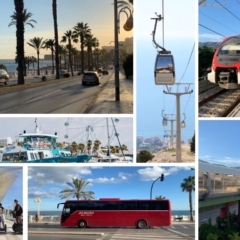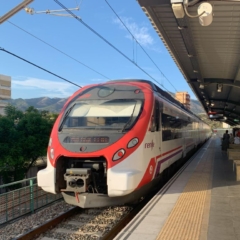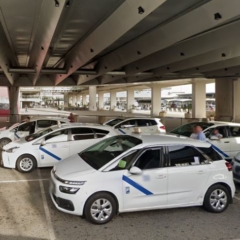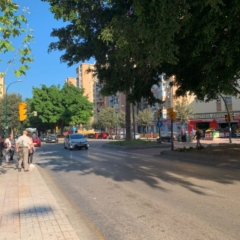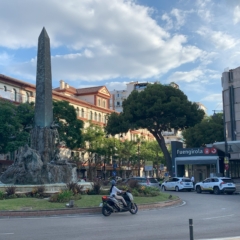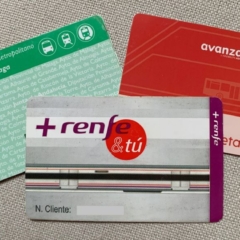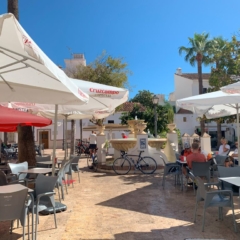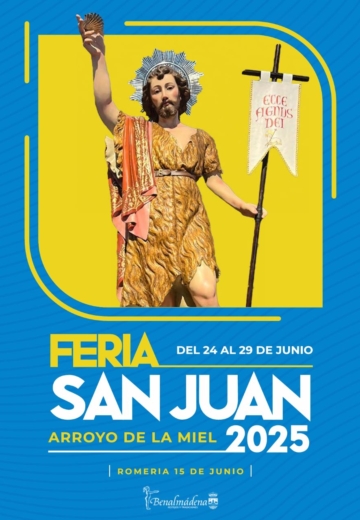Solving parking and parking tickets in the Costa del Sol

It is often difficult to find a parking spot in Spain, but findind parking tickets in the Costa del Sol, on the windshields of the cars, is not uncommon. The situation gets worse during summer, semana santa (holy week) and other celebrative times when there are many cars around, and even worse in some popular places – like near the beaches or touristic areas, for instance. So if you just moved to Spain or if you are travelling and found an irresistible offer at Discovercars, there are a few things you should know in order to avoid trouble. Follow the tips below and get your mind at ease!
The Basics
In principle, in Spain you are allowed to park along the sidewalks when there is no yellow line. A continuous yellow line means no parking or stopping – the same as a double crossed vertical sign, as shown on the picture. A dashed line or a chevron yellow line mean no parking (but it is ok to stop briefly, to let someone out of the car).

The dashed and the chevron lines both mean the same as a vertical sign with only one line across. The difference between them is that the chevron line also indicates that this area is used by buses either to stop or to maneuver – so you know that if you park there, towing will come really fast. Sometimes the yellow chevron can indicate motorbike parking, but then there will be a vertical sign clarifying that.
People can’t park along roundabouts or garage exits, obviously, regardless of any markings; nor are allowed to double park. Despite the rule, roundabouts are very commonly used as parking lots, at risk of towing or fine. Lines on the floor made with other colors, such as orange or green mean that parking in this area is restricted to people with a permit; it is sometimes the case of buildings that restrict parking only to residents.
The blue zones
The other important color of lines on the floor is blue. When there are blue markings on the road, that means that it’s a paid parking zone, called zona azul (blue zone). You can park there, but then you should either pay at the blue parking meter that will be present in every blue zone, or using either Telpark or Easy Park, that we will see further on.
Above: example of blue zone and a parking meter.
Also of notice is that some ‘no parking’ signs have messages under it. They usually specify days and/or hours when parking is not allowed – but parking out of that time is ok. In the example below, it reads laborales de 9 a 14 y de 16 a 20h excepto carga y descarga – which means (Forbid to park on) working days from 9:00 am to 2:00 pm and from 4:00 pm to 8:00 pm except for loading and unloading.
Likewise, blue zones also have free-to-park hours; they can vary from one location to another and depending on the time of the year; you can find this information on the parking meters. They are usually free on Sundays and holidays, at night and during the siesta hours; as an example and according to ZonaAzul, these are the free-parking times for Benalmádena:
From June 1 st to September 14:
Monday to Fridays: free up to 09:00 am, from 2:00 pm to 5:00 pm and from 9:00 pm on.
Saturdays: free up to 09:00 am and from 2:00 pm.
Sundays and holidays: free parking all day.
From September 15 to May 31st:
Monday to Fridays: free up to 09:00 am, from 2:00 pm to 4:00 pm and from 8:00 pm on.
Saturdays: free up to 09:00 am and from 2:00 pm.
Sundays and holidays: free parking all day.
Residents can park at blue zones for as long as they want, while non-residents can stay only up to 3 hours. That being said, it is often the case that you find nowhere to park. So what to do? Well, go to the supermarket!
The supermarket hack
A good thing to do is to find the nearest supermarket to the place where you are driving, and park on their parking lot. They just allow customers to park, but as long as you spend a certain amount of money there (which varies from market to market, but tends to be around 20 euros), you are good to go.
Make sure you first go where you need to go and do the shopping on your way back. That’s because after you pay your market bill, you just have 20 minutes to leave the parking lot, but there is (as far as I know) no time limit to be ‘shopping’. Important: don’t leave your car overnight on a market parking lot or it may be towed.
Telpark or Easy Park
Even if you find parking in the street, odds are it will be in a blue zone and that the parking meter will not work. I gave up on the meters on my first month driving in Spain, when I found out about Telpark.
Telpark’s life saving (well, fine saving 😊) free app let’s you pay for parking directly from the app. You will need to fill in some basic data about your car – model, make and license plate – and some about yourself; once you park, access the app and it will point out your location in a map. You can adjust it, if necessary, then confirm your position. Next, it will ask you how long you are going to stay – you can give an estimate and change it later. Better to give yourself extra time and edit it when you go back to the car, just in case. You pay just for what you use.
I know that Easy Park is also available in the Costa del Sol, but I have not used it yet. If one app doesn’t cover your area, try the other; one of them should do the job 😉

My Telpark account is connected to my bank account, so it is paid straightaway; I think it is possible to pay with a card too. So far, so good. Telpark also offers the possibility of booking a long-time parking spot ahead, but I never used this option. The other feature it includes is the possibility of paying fines, which takes us to the next topic.
Paying parking tickets in the Costa del Sol
Oopsie-daisy, they got you. My solidarities, I’ve had my share of fines too, just not yet in Spain. Or maybe I didn’t see the tickets, because they are small pieces of paper left on the windshield of the car – the fines look like a small register ticket from the supermarket; it states how much you should pay, but it doesn’t mention where and how. You may just notice it later, after arriving home. In any case, you have a few options:
– you may try to pay it on the nearest parking meter, that blue thing you find in blue zone side-walks. If it is not broken, this can be a good option. You can certainly ask for help from a nearby Spaniard, they are great.
– you can go to the post office, where you often can pay it;
– you can go to the police, and they will either receive the payment or point you to a bank to pay it;
– you can go to the Town Hall – where they may decline to see you if you didn’t book a prior appointment – and they will do the same as in the police, or…
– you can use Telpark and pay your fine easily, regardless of when you found the ticket. I would use this option.
Good to know: If you pay within the first 20 days after the ticket was issued, you get a 50% discount on the fine!
Conclusion
So you see, there are options for (legal) parking and ways to avoid tickets; if you still happen to be fined, you know how to proceed. I recommend getting the Telpark app as soon as you get a car in Spain – your own or a rented one – as it is a lot easier to find a parking spot in a blue zone than in a free one, and it would be a shame to miss a great parking spot for cents (yes, blue zones are paid, but usually very cheap). Remember to check the supermarkets nearby too. Enjoy the streets of Spain like a pro and happy parkings!
